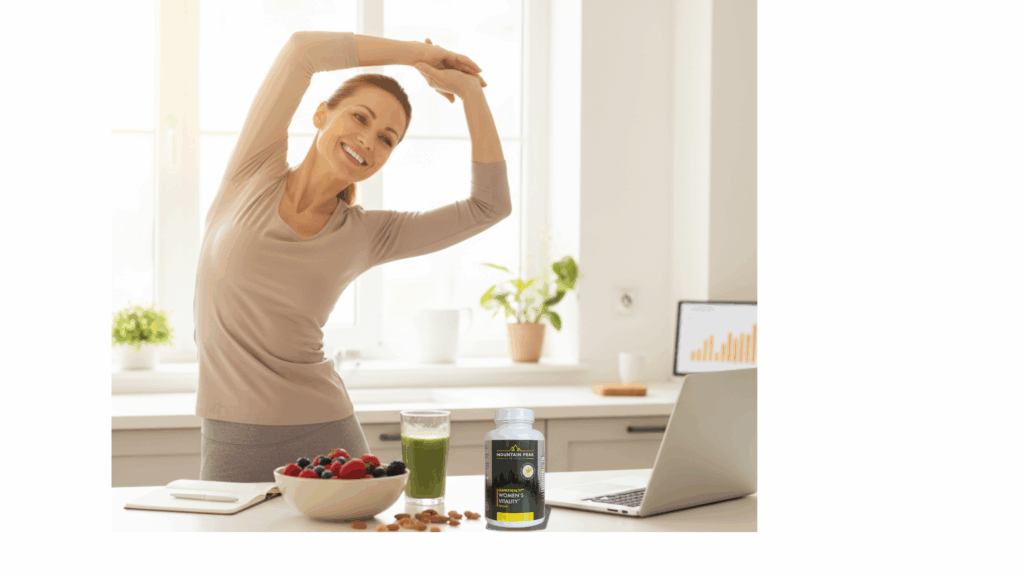Women’s Vitality After 40: Nutrition & Lifestyle Strategies for Midlife Energy
As women enter their 40s and cruise into later years, maintaining (or regaining) vitality and energy becomes the priority. Women’s midlife vitality depends on natural energy sources, specific women’s nutrition, and targeted female supplements to combat the shifts of perimenopause and menopause. For women 40+ energy levels can fluctuate due to hormonal changes and the challenges of a lifetime of gaining wisdom (and some grey hair), but with the right strategies, it’s possible to reclaim that spark and truly thrive. So, don’t be scared… it’s time to go from the anchors of worry and fatigue to set sail into your devil-may-care bliss of your new body!
Women’s Exercise: Did you know a sedentary lifestyle is considered a worse risk factor than smoking now? This is why a heavy hitter for boosting wellness is incorporating daily movement into your routine, with a goal of 30 mins per day or 210 mins per week total. With exercises like brisk walking, yoga, Pilates, and strength training, you can lift your mood and burn more fat! Regular physical activity provides natural energy by improving circulation to brain and body, building muscle for strength and heart health, supporting mental clarity, and even preventing brain deterioration. Start small if you’ve been a couch potato, don’t judge your body, but just be thankful you can move the one you have! Pro tip: many gyms offer a free personal training session and/or reduced-price training session packages when you sign up.
Women’s Nutrition: Fuel your movement with a solid nutrition strategy tailored for women 40+ and go for progress, not perfection! Focus on high-protein foods like lean meats, fish, poultry, eggs, legumes, tofu, and low-fat dairy to preserve muscle mass and stabilize blood sugar. High protein diets raise a pancreatic hormone called glucagon, which makes you feel full. For an insider perspective, glucagon is the G in GLP-1 but it doesn’t cost extra! 😉
To go with your protein, healthy fats from avocados, nuts, and olive oil provide sustained energy and support cholesterol health. Olive oil is particularly interesting because it helps the immune system clean out the garbage we all carry, including cancer cells. It’s especially good for this while doing a 24-hour water fast (more on that below). Adding a teaspoon of olive oil every 4 hours to your water fast amplifies waste cleanup! Just make sure to discuss with your doctor before embarking on any long fasts.
For cholesterol quality and gut health, don’t overlook soluble fiber from psyllium husks, oats, apples, and beans. To help with zapping insulin resistance (affecting most women over 40) consider adding apple cider vinegar to a glass of water or on some leafy greens before meals! Even just a tablespoon daily is shown to improve insulin sensitivity, promoting steadier blood sugar and energy throughout the day!
Insulin Sensitivity in Peri- and Post-menopause: Nobody wants to develop diabetes and insulin sensitivity is the key to preventing that diagnosis in most cases. Insulin is a good thing that our bodies use to move energy into cells, but when we have too much too often, we become resistant to it and we gain deadly visceral fat around our organs and body fat that we may not want more of. For peri- and postmenopausal women, where circulating estrogen is lower and the ovaries no longer require as much glucose, certain dietary strategies really shine. Fasting (like 24-hour water fasting), time-restricted feeding (like eating within an 8-10 hour window daily), and low-carb diets can be particularly beneficial. These methods help optimize insulin response, reduce body-wide inflammation, and enhance fat burning for natural energy without suffering a rollercoaster of glucose spikes and drops. By aligning with your body’s evolving needs, these practices support the whole body metabolically and make midlife feel more empowered. Just remember to get electrolytes and plenty of water in while you fast, and always under a healthcare provider’s supervision.
Supplementing for Support: To complement nutrition and lifestyle changes, natural female supplements like Mountain Peak Nutritionals Women’s Vitality offer targeted support for women over 40 navigating those pesky (sometimes ghastly) hormonal shifts. This doctor-formulated blend is designed to address symptoms of perimenopause and menopause, promoting overall balance and energy when women need it most. Many of the herbs included have been used by wise women for millennia to help with graceful aging!
Here’s a quick list of Women’s Vitality key features for the journey at hand:
Hormonal Balance Support: Contains black cohosh, chaste tree berry, and Dong Quai to modulate luteinizing hormone (a brain hormone that tells the ovaries to release eggs) and maintain healthy estrogen and progesterone levels, reducing mood swings and cramping.
Relief from Menopausal Symptoms: Helps alleviate occasional hot flashes, night sweats, and diminished interest in intimacy through a proprietary blend of herbal extracts like wild yam and soy isoflavones (a molecule that acts as a type of plant-estrogen helpful to women).
Improved Sleep and Stress Management: Passionflower and licorice extracts promote relaxation and better sleep quality, combating sleeplessness common in midlife.
Adaptogenic Properties: Ingredients like burdock and Dong Quai act as adaptogens, enhancing resilience to stress and supporting sustained natural energy.
Nutrient Foundation: Includes magnesium citrate for overall hormonal regulation and 350+ enzymatic processes in the body, in vegetarian capsules for easy daily use.
Usual dose is 1 capsule, 3 times daily with food, or as directed by a healthcare provider.
This supplement doesn’t contain hormones but uses nutrients to address underlying imbalances, making it a gentle option for women 40+ seeking solutions other than hormone replacement therapy. While not all women choose this path, talking to your doctor about hormone replacement therapy options is prudent when entering perimenopause, to find out if it’s right for you.
Breast Cancer Awareness: Breast cancer significantly impacts women over 40, as age is a primary risk factor with most cases occurring in those 50 and older, though risks rise steadily from 40 onward due to cumulative exposure to hormone disruptors like plastic and body care or cosmetics, genetic factors, and lifestyle influences including a sedentary lifestyle or alcohol dependence. Women in this age group face higher incidence rates, especially when ovulation declines and hormones drop, with factors like dense breasts or family history amplifying risks. Outcomes can be improved through proactive measures that address metabolic and hormonal health.
As discussed earlier, maintaining steady blood glucose is key, as high fasting glucose and insulin resistance are linked to worsened cancer prognosis (outcomes over the term of treatment), increased proliferation (growth) of cancer cells, and higher recurrence rates in breast cancer patients. Controlling blood sugar through diet and lifestyle, using the tips outlined above, may reduce these risks and enhance survival.
Getting plenty of sleep and stress relief further improves outcomes. Poor sleep is associated with increased cancer recurrence and mortality (not to mention brain diseases), while good sleep (7-8 hours) may reduce risk and improve survival. Consider stress reduction strategies, such as mindfulness-based stress reduction (MBSR), deep breathing exercises, prayer, massage therapy, sauna, and the like. All of these can be helpful to lower anxiety, fatigue, depression, and disease progression by targeting pathways like β-adrenergic signaling (adrenal health) to make coping easier. When people lose hope or can’t bounce back from stressful situations, health suffers.
Coming back to how we eat, insulin resistance makes for a poor night’s sleep, so ensuring optimal nutrition is even more important in the category of optimal sleep. With few exceptions, a major keynote symptom of people who have poor blood glucose control is that they wake to pee in the middle of the night regularly or multiple times per night. By controlling blood sugar, sleep is less likely to be interrupted!
Mountain Peak Nutritionals Women’s Vitality can support these goals for women over 40. Its ingredients promote hormone balance through herbs like black cohosh and chaste tree, which may aid in managing estrogen-related symptoms. It addresses sleeplessness with passionflower, potentially improving sleep quality. The adaptogenic elements offer stress relief by reducing mood swings and anxiety. While not directly targeting blood glucose, the overall hormonal support could indirectly contribute to metabolic stability, especially when combined with nutrition and lifestyle strategies. Always consult a healthcare provider before starting any supplement to make sure it’s safe and effective for you and your specific needs.
Together we can all pledge to improve our health as an example to those around us and get the most quality from our lives as possible. Using some or all of the strategies discussed above is a great starting point. When women lead healthier lives, it rubs off on everyone around them.
October is Breast Cancer Awareness Month, so during this time and always, remember to hold closely the ones you love, and take care of yourself too, as there are those who love you.
References
- Bluming, A., & Tavris, C. (2018). Estrogen Matters: Why Taking Hormones in Menopause Can Improve Women’s Well-Being and Lengthen Their Lives—Without Raising the Risk of Breast Cancer. Little, Brown Spark. https://www.hachettebookgroup.com/titles/avrum-bluming/estrogen-matters/9780316481205/
- Goodwin, P. J., et al. (2011). Insulin and breast cancer outcome. Breast Cancer Res Treat, 128(1), 203–211. https://pubmed.ncbi.nlm.nih.gov/21197565/
- Villarreal-Garza, C., et al. (2017). Diabetes and breast cancer prognosis. The Oncologist, 22(8), 923–929. https://www.ncbi.nlm.nih.gov/pmc/articles/PMC5553969/
- Carlson, L. E., et al. (2017). Mindfulness and telomere length in breast cancer. Cancer, 123(3), 476–484. https://www.ncbi.nlm.nih.gov/pmc/articles/PMC5298036/
- Palesh, O., et al. (2014). Sleep disruption in breast cancer. J Natl Compr Canc Netw, 12(12), 1717–1724. https://pubmed.ncbi.nlm.nih.gov/25538057/
- Marinac, C. R., et al. (2016). Nightly fasting and breast cancer. JAMA Oncol, 2(8), 1049–1055. https://www.ncbi.nlm.nih.gov/pmc/articles/PMC4982784/
- Cole, S. W., et al. (2015). Stress and tumour microenvironment. Nat Rev Cancer, 15(9), 563–572. https://www.ncbi.nlm.nih.gov/pmc/articles/PMC4698954/
- (2023). Breast cancer statistics. https://www.cdc.gov/breast-cancer/statistics/
- org. (2023). Risk factors. https://www.breastcancer.org/risk/risk-factors
- Chen, M., et al. (2023). Black cohosh extracts in women with menopausal symptoms: an updated pairwise meta-analysis. Pharmacol Res, 193, 106800. https://pubmed.ncbi.nlm.nih.gov/37192826/
- Wuttke, W., et al. (2003). Chaste tree (Vitex agnus-castus)–pharmacology and clinical indications. Phytomedicine, 10(4), 348-357. https://pubmed.ncbi.nlm.nih.gov/12809367/
- Halder, S., et al. (2019). Vitex agnus-castus in premenstrual syndrome: A meta-analysis of double-blind randomised controlled trials. Complement Ther Med, 46, 102166. https://pubmed.ncbi.nlm.nih.gov/31780016/
- Lau, C. B., et al. (2005). Use of dong quai (Angelica sinensis) to treat peri- or postmenopausal symptoms in women with breast cancer: is it appropriate? Menopause, 12(6), 734-740. https://pubmed.ncbi.nlm.nih.gov/16278617/
- Hirata, J. D., et al. (1997). Does dong quai have estrogenic effects in postmenopausal women? A double-blind, placebo-controlled trial. Fertil Steril, 68(6), 981-986. https://pubmed.ncbi.nlm.nih.gov/9418683/
- Komesaroff, P. A., et al. (2001). Effects of wild yam extract on menopausal symptoms, lipids and sex hormones in healthy menopausal women. Climacteric, 4(2), 144-150. https://pubmed.ncbi.nlm.nih.gov/11428178/
- Wu, W. H., et al. (2005). Estrogenic effect of yam ingestion in healthy postmenopausal women. J Am Coll Nutr, 24(4), 235-243. https://pubmed.ncbi.nlm.nih.gov/16093400/
- Howes, L. G., et al. (2006). Evaluation of the cardiovascular effects of short-term soy isoflavone supplementation in menopausal women. J Clin Endocrinol Metab, 91(7), 2708-2714. https://pubmed.ncbi.nlm.nih.gov/16608893/
- Janda, K., et al. (2020). Passiflora incarnata in Neuropsychiatric Disorders-A Systematic Review. Nutrients, 13(1), 142. https://pubmed.ncbi.nlm.nih.gov/33352740/
- Amin, G., et al. (2019). Impact of Glycyrrhiza glabra (licorice) vaginal cream on vaginal signs and symptoms of vaginal atrophy in postmenopausal women: A randomized double blind controlled trial. J Ethnopharmacol, 243, 112070. https://pubmed.ncbi.nlm.nih.gov/32257873/
- Hajirahimkhan, A., et al. (2013). Evaluation of estrogenic activity of licorice species in comparison with hops used in botanicals for menopausal symptoms. PLoS One, 8(7), e67947. https://pubmed.ncbi.nlm.nih.gov/23874474/
- Chan, M. F., et al. (2011). A review of the pharmacological effects of Arctium lappa (burdock). Inflammopharmacology, 19(5), 245-254. https://pubmed.ncbi.nlm.nih.gov/20981575/
- Ha, H., et al. (2021). Exercise training and burdock root (Arctium lappa L.) extract independently improve abdominal obesity and sex hormones in elderly women with metabolic syndrome. J Nutr Biochem, 93, 108630. https://pubmed.ncbi.nlm.nih.gov/33664334/


